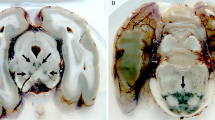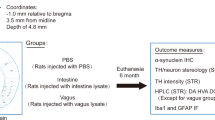Abstract
HUMAN consumption of lathyrus peas, especially during periods of famine, has long been associated in certain parts of the world with outbreaks of neurolathyrism, a crippling neurological disorder characterised by spastic paraplegia1. A neuroexcitatory2 amino acid, β-N-oxalyl-L-α,β-diaminopropionic acid (ODAP), isolated from the seeds of Lathyrus sativus3 is suspected to be the responsible neurotoxic principle. Although paralysis of the lower extremities has been reported in adult monkeys after lumbar intrathecal administration of ODAP4, and similar symptoms have been induced in newborn chicks by intraperitoneal administration3, evidence for central nervous tissue damage from systemically administered ODAP has been lacking. We now report that ODAP, administered intraperitoneally to immature mice, induces lesions in the retina, hypothalamus and lower medulla. This pattern of damage is similar to that demonstrated in animals after oral or subcutaneous administration of glutamate (Glu).
This is a preview of subscription content, access via your institution
Access options
Subscribe to this journal
Receive 51 print issues and online access
$199.00 per year
only $3.90 per issue
Buy this article
- Purchase on Springer Link
- Instant access to full article PDF
Prices may be subject to local taxes which are calculated during checkout
Similar content being viewed by others
References
Sarma, P. S., and Padmanoban, G., in Toxic Constituents of Plant Foodstuffs (edit. by Leiner, I. E.), 267–274 (Academic, New York, 1969).
Watkins, J. C., Curtis, D. R., and Biscoe, T. J., Nature, 211, 637 (1966).
Rao, S. L. H., Adiga, P. R., and Sarma, P. S., Biochemistry, 3, 432–436 (1964).
Rao, S. L. N., Sarma, P. S., Morri, K. S., Rao, T. R., and Sriramachari, S., Nature, 214, 610–611 (1967).
Johnston, G. A. R., Biochem. Pharmac., 22, 137–140 (1973).
Olney, J. W., Science, 164, 719–721 (1969).
Olney, J. W., and Ho, O. L., Nature, 227, 609–610 (1970).
Olney, J. W., Ho, O. L., and Rhee, V., Expl Brain Res., 14, 61–76 (1971).
Olney, J. W., Rhee, V., and Ho, O. L., Brain Res., 77, 507–512 (1974).
Curtis, D. R., and Watkins, J. C., J. Physiol., Lond., 155, 1–14 (1963).
Shinozaki, H., and Konishi, S., Brain Res., 24, 368–371 (1970).
Olney, J. W., J. Neuropath. exp. Neurol., 30, 75–90 (1971).
Olney, J. W., J. Neuropath. exp. Neurol., 28, 455–474 (1969).
Lemkey-Johnston, N., and Reynolds, W. A., J. Neuropath. exp. Neurol., 33, 74–97 (1974).
Olney, J. W., Rhee, V., and de Gubareff, Brain Res. (in the press).
Olney, J. W., Misra, C. H., and De Gubareff, T., J. Neuropath. exp. Neurol., 34, 167–177 (1975).
Balcar, V. J., and Johnston, G. A. R., J. Neurobiol., 3, 295–301 (1972).
Author information
Authors and Affiliations
Rights and permissions
About this article
Cite this article
OLNEY, J., MISRA, C. & RHEE, V. Brain and retinal damage from lathyrus excitotoxin, β-N-oxalyl-L-α,β-diaminopropionic acid. Nature 264, 659–661 (1976). https://doi.org/10.1038/264659a0
Received:
Accepted:
Issue Date:
DOI: https://doi.org/10.1038/264659a0
This article is cited by
-
Oxidative mechanisms involved in kainate-induced cytotoxicity in cortical neurons
Neurochemical Research (1994)
-
Effect of beta-N-oxalylamino-l-alanine on cerebellar cGMP level in vivo
Neurochemical Research (1993)
-
Purkinje cell toxicity ofβ-aminopropionitrile in the rat
Virchows Archiv A Pathological Anatomy and Histopathology (1991)
Comments
By submitting a comment you agree to abide by our Terms and Community Guidelines. If you find something abusive or that does not comply with our terms or guidelines please flag it as inappropriate.



